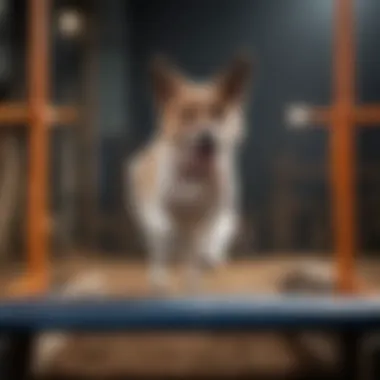Mastering Dog Agility Sets for Better Training


Intro
Dog agility sets have gained popularity among pet owners wishing to enhance their dog’s training and performance. These sets consist of various obstacles such as jumps, tunnels, and weave poles, designed to stimulate a dog's physical capabilities and mental acuity. This article aims to elucidate the multifaceted aspects of dog agility sets. We will explore the design principles, benefits, applications in different environments, and the maintenance required to ensure their longevity. Understanding these components will empower pet owners to make informed decisions, enriching their dogs' experiences and skills.
Pet Care Essentials
Daily Nutrition Requirements
A dog's energy levels are crucial for agility training. Proper nutrition serves as a foundation for performance. High-quality dog food rich in proteins, vitamins, and minerals contributes to muscle development and stamina. Ingredients like chicken, lamb, and fish should be sources of protein. The right balance ensures that dogs maintain their agility over time.
Exercise and Playtime
Regular exercise complements agility training. It is essential to combine agility drills with other forms of physical activities. Taking your dog for long walks or engaging in playful games promotes overall fitness. This not only prepares them for agility courses but also prevents obesity and boredom.
Grooming Tips
Maintaining a well-groomed dog is essential for agility training. Regular brushing helps avoid matting, which can hinder movement. Bathe your dog to keep its coat clean, especially after outdoor agility sessions. Nail trimming is equally important, as long nails can cause discomfort during running or jumping.
Health and Wellness Check-ins
Regular veterinary visits ensure that your dog remains in peak condition. Vaccinations, dental care, and routine check-ups play a critical role in maintaining health. Observing changes in behavior or physical condition can provide early warnings for potential health concerns.
Behavior & Training
Understanding Your Pet's Body Language
Recognizing and interpreting your dog’s body language is key to effective training. For example, wagging tails usually indicate excitement or happiness, while raised hackles might signal anxiety or aggression. Understanding these signals helps in modifying training approaches for better outcomes.
Basic Training Techniques
Positive reinforcement is one fundamental approach to dog training. Encouraging desired behaviors with treats or verbal praises helps establish trust. Basic commands such as sit, stay, and come should be mastered before progressing to agility obstacles. This foundational training is crucial for successful agility performance.
Behavioral Concerns & Solutions
Some dogs may exhibit behavioral issues such as nervousness or distraction during training. It is important to address these concerns through gradual exposure and consistent training. Techniques like desensitization and counter-conditioning can be effective in overcoming these challenges.
Socialization Tips
Engaging with other dogs and people is vital for socialization. Bringing your dog to group training sessions or agility classes allows them to learn appropriate behaviors within a controlled environment. This exposure is invaluable for building confidence and reducing anxiety during competitions.
Pet Home Environment
Creating a Pet-friendly Space
Designing a pet-friendly environment is essential for both training and leisure. Ensure that your home has enough space for agility equipment, while also being safe for your dog to practice. A clean and spacious area prevents accidents and enhances the overall experience.
Safety Measures and Hazards to Avoid
When training with agility sets, it’s necessary to monitor the training environment. Remove any objects that could cause injuries, such as sharp tools or slippery surfaces. Safety should be a priority to prevent accidents during training.
Choosing the Right Toys and Accessories
Select toys and accessories that are suitable for your dog's size and energy level. Durable items can withstand the rigors of agility training and play. Look for products made from non-toxic materials to ensure your dog’s safety.
Setting Up a Comfortable Resting Area
After training sessions, a comfortable resting area is crucial for recovery. Provide a soft bed or mat where your dog can relax and recuperate. This fosters a sense of security and well-being, allowing for better performance in training.
Pet Health Issues
Recognizing Signs of Illness
Being vigilant about your dog’s health is essential. Spontaneous changes in appetite, energy levels, or behavior may indicate health issues. Promptly consult with a veterinarian if any unusual signs arise.
Preventative Care Measures
Preventative care, including vaccinations and regular health screenings, can detect issues before they become serious. Maintaining a grooming schedule also plays a role in preventing skin or dental diseases, enhancing your dog’s overall health.
Common Ailments and Treatments
Familiarize yourself with common ailments such as allergies or digestive issues. Knowing the symptoms enables quick action. Treatments can vary from dietary adjustments to medications, depending on the situation.
Emergency Preparedness
Preparing for emergencies is critical. Have a basic first aid kit for pets and know the location of the nearest veterinary clinic. Being ready can save time and stress during critical moments.
Prelims to Dog Agility Sets
Dog agility sets are invaluable tools for enhancing the training and performance of canines. These sets consist of various obstacles and equipment designed to challenge dogs physically and mentally. The growing interest in dog agility reflects its benefits, not only for improving canine skills but also for creating a stronger bond between pets and their owners. Consideration of the design, materials, and proper usage of these sets is essential for maximizing their potential.
Definition and Purpose
Dog agility refers to a sport that involves dogs navigating through a timed course of obstacles. The purpose of agility sets is to facilitate structured training that hones a dog's ability to follow commands and maneuver through various challenges. This training promotes physical fitness and mental stimulation. Owners can teach their dogs to respond rapidly to commands, which enhances communication between them. Ultimately, this strengthens the relationship between dog and handler, making the activity both rewarding and enjoyable.
History of Dog Agility Sports
The origin of dog agility sports can be traced back to a demonstration at the Crufts Dog Show in the late 1970s. This exhibition captured the interest of spectators and participants alike, leading to the development of structured agility competitions. Initially inspired by horse jumping events, dog agility evolved into a distinct sport with its own rules and formats.
Today, agility sports have gained international recognition and are governed by organizations such as the American Kennel Club. Various competitions are held worldwide, providing opportunities for dog owners to showcase their pets’ abilities. The history of this sport is indicative of its growing status in canine culture, marking a significant development in how dogs can be trained and showcased.
Components of a Dog Agility Set


The components of a dog agility set play a critical role in shaping the training experience for both the dog and the handler. Each piece of equipment is designed with specific functions and challenges, contributing to the development of a dog's agility skills. By understanding the individual elements within a dog agility set, owners can make well-informed choices that align with their dog's capabilities and training objectives.
Obstacles and Equipment Types
Dog agility courses consist of various types of obstacles that enhance a dog's training and performance skills. These obstacles encourage physical activity and improve coordination.
Jumps
Jumps are a fundamental component of any agility set. They typically consist of two vertical poles with a horizontal bar placed between them. The key characteristic of jumps is their height and the distance between poles, making them an essential choice for agility training. Jumps help to develop a dog's leaping ability and overall physical fitness.
One unique feature of jumps is that they can be adjusted to different heights, which accommodates dogs of all sizes and abilities. This adjustability offers both advantages and disadvantages; while it allows for customized training sessions, it may also lead to confusion for dogs transitioning between heights.
Tunnels
Tunnels provide an exciting challenge for dogs, as they encourage dogs to run through a confined space. The main contribution of tunnels is to test a dog's confidence and focus while navigating an enclosed structure. Tunnels are appealing because they stimulate a dog's natural curiosity and playfulness.
The unique feature of tunnels is their flexible design, which can often be curved or extended. This flexibility allows handlers to create various configurations and challenges. However, this also means that handlers must pay attention to their dog's comfort level; some dogs may initially hesitate to enter a tunnel, requiring patience and encouragement.
Weaves
Weave poles require precision and agility, making them both a beneficial and popular choice in dog agility training. This equipment consists of a line of freestanding poles that dogs must navigate through in a specific pattern. Weaves promote cognitive skills and enhance a dog's ability to change direction quickly.
The unique feature of weave poles is that they force dogs to think critically about their movements. The challenge presented by weaves can lead to frustration if not approached appropriately. Therefore, gradual introduction and reinforcement through positive training methods are essential to overcome any difficulties.
Contacts
Contact equipment, which often includes ramps and planks, is designed to test a dog's ability to control speed and precision. The critical aspect of contacts in an agility set is their elevated structure, requiring the dog to make adjustments while being aware of their position.
A unique feature of contact equipment is the use of color differentiation or surface textures to indicate the safe zones for dogs to place their paws. This visual and sensory aid enhances the training experience. However, if the surface is too slippery or the height is too daunting, it can lead to a lack of confidence in some dogs.
Material Considerations
The material used in the construction of agility equipment is crucial for ensuring safety, durability, and usability. Pet owners should consider material properties when selecting agility sets.
Durability
Durability is a significant aspect of any agility set, as it determines how well the equipment withstands the rigors of training. High-quality materials, such as heavy-duty plastics and steel, are essential for lasting use. Durable equipment is beneficial because it minimizes the need for frequent replacements, ultimately saving money in the long run.
One unique feature of durable materials is their ability to maintain structural integrity even under adverse weather conditions. However, some durable materials may be heavier and less portable, limiting set-up flexibility.
Weather Resistance
Given that agility training often takes place outdoors, weather resistance is another important consideration. Good weather-resistant materials prevent rusting, fading, and deterioration over time. This characteristic makes it a favorable choice for those training in different climates.
The unique aspect of weather-resistant materials is their ability to ensure longevity and reliability in various environments. However, some weatherproof materials may be costlier than standard options, which is an essential consideration for budget-conscious pet owners.
Safety Features
Safety features are non-negotiable in any agility set. Equipment needs to have smooth edges, secure connections, and stable bases to prevent injuries during training sessions. Safety features help to build confidence in performance and make training sessions more enjoyable.
One unique characteristic is the addition of non-slip surfaces on equipment, which prevents accidents during high-speed maneuvers. The drawback is that safety features often increase the cost of equipment, necessitating a careful balance between affordability and safety.
Choosing the Right Agility Set
Choosing the right agility set is crucial for maximizing both the training experience and the effectiveness of agility practice. An appropriate set enhances your dog’s ability to perform agility tasks while ensuring safety and enjoyment. Selecting the right set involves understanding your dog’s specific needs, financial constraints, and the space available for training.
Assessing Your Dog's Needs
Age
Age is a significant factor when selecting an agility set. Young dogs may have high energy levels and require sets that can withstand vigorous activity. Conversely, older dogs might have different abilities, necessitating gentler equipment. For example, a younger dog could benefit from a higher jump set to challenge their skills, while an older dog might fare better with lower obstacles that prevent strain. Determining a dog’s age helps tailor the agility experience.
Breed
Breed plays a notable role in choosing an agility set. Certain breeds excel in agility due to their natural traits. Border Collies, for instance, are known for their agility and responsiveness, making them well-suited for more complicated sets. On the other hand, a Bulldog might require adaptations in equipment design. It's important to consider how a breed’s strengths can influence the right choices in agility training.
Fitness Level
Fitness level is another key aspect of assessing your dog’s needs. A dog that is already fit may navigate a full agility set with ease, while a less active dog could require a more gradual introduction. Equipment should accommodate the current fitness level, allowing for both challenge and enjoyable exercise. It’s wise to introduce new obstacles slowly, ensuring your dog can adapt without risking injury.
Budget Considerations
Budget considerations are vital when selecting an agility set. The market offers a range of products from high-end to more affordable options. Investing wisely helps to ensure you choose equipment that is durable and fits your needs without overspending. Consider not only the initial costs but also the potential for future adjustments or expansions. Quality often correlates with value, so look for sets that balance both factors.
Space Requirements
Space requirements cannot be overlooked. Sufficient training area is essential for safely using an agility set. Dogs need room to explore and practice agility movements. Measure your training area before selecting an agility set, ensuring it is large enough to accommodate the equipment and provide ample space for your dog to move freely. Designing your training space around the agility set can dramatically enhance the learning experience.
Training Techniques for Agility
Training techniques relevant to dog agility are crucial for success in this sport. Understanding how to effectively train a dog can greatly enhance both performance and the enjoyment of the activity. Knowing the basic commands is fundamental. This gives a clear communication path between the handler and the dog. Confidence building during training is equally important. Both elements contribute significantly to the overall outcome of agility training.
Basic Commands and Their Importance
Teaching basic commands is the first step in training any dog for agility. These commands serve as the foundation of all advanced skills. In agility, commands like "sit," "stay," "come," and "heel" are essential. They ensure that dogs remain responsive during training routines and competitions.
Tips for teaching basic commands:
- Start with short training sessions.
- Use rewards such as treats or praise.
- Be consistent with commands and cues.
- Practice these commands regularly, both in isolation and in various environments.
The importance of these commands cannot be understated. They promote not only good behaviour but also a strong bond. This bond deepens the understanding between the dog and handler, which is crucial in agility events.


Building Confidence through Agility Training
Building a dog's confidence is intricate to successful agility training. Many dogs may feel intimidated by the obstacles at first. Gradual exposure to these challenges can help alleviate fears. Training should be fun and rewarding, focusing on encouraging the dog at each stage.
Methods to build confidence include:
- Starting with low-height jumps and simple tunnels.
- Allowing the dog to explore obstacles at their own pace.
- Using positive reinforcement to celebrate small victories.
- Incorporating play into training sessions.
Through this gradual approach, dogs learn to trust their abilities. This trust not only enhances performance but also strengthens the companionship between dog and handler. Agility training thus evolves from a series of tasks to a collaborative and enjoyable experience.
"Confidence in a dog's training is as vital as their physical capabilities in agility sports."
Benefits of Dog Agility Training
Dog agility training offers a spectrum of benefits, enhancing the health and well-being of dogs while also fostering a strong bond between pets and their owners. These positive outcomes can be broadly categorized into two main areas: physical health advantages and mental stimulation and engagement. Both aspects are crucial for a dog's overall quality of life and contribute to their happiness and behavior.
Physical Health Advantages
Engaging in dog agility training significantly promotes physical health.
- Cardiovascular Fitness: Agility training involves various activities that elevate heart rate. Dogs running through tunnels and jumping over obstacles develop stronger hearts and improved cardiovascular health.
- Muscle Development: Navigating through agility sets builds muscles, particularly in the legs, core, and back. This development helps maintain overall canine strength and balance. By regularly exercising these muscles, owners can notice enhanced performance in daily activities, such as walking or playing.
- Flexibility and Coordination: The irregular movements involved in agility training enhance flexibility. Dogs learn to pivot, twist, and maneuver skillfully through obstacles, ultimately improving coordination. Owners will see their dogs become more agile and responsive in various situations.
- Weight Management: Regular training sessions help in controlling body weight. With obesity increasingly common in pets, agility serves as a thrilling way to keep dogs active and engaged, preventing excessive weight gain.
expert tip: Regular exercise, like agility training, is shown to extend a dog’s lifespan by keeping them fit and healthy.
Mental Stimulation and Engagement
The mental benefits of dog agility training are equally essential, ensuring dogs remain sharp and fulfilled.
- Cognitive Challenges: Agility training requires dogs to think and make quick decisions. They learn to memorize sequences, recognize cues from their handlers, and plan their movements. This mental engagement keeps their brains active.
- Behavioral Improvements: Well-trained, mentally stimulated dogs exhibit fewer behavioral issues. They are less likely to engage in destructive behaviors often linked to boredom or lack of activity. Consequently, it fosters a more harmonious household.
- Strengthened Human-Dog Bond: Working together during agility training enhances the bond between dogs and their owners. Trust is built as dogs listen to their handlers and respond to commands. This relationship can lead to a healthier, more fulfilling life for both canine and human.
- Stress Relief: Engaging actively in agility exercises can reduce anxiety in dogs. A focused activity helps them channel excess energy and alleviate stress, making them calmer at home.
"Proper training enriches a dog’s life both physically and mentally, leading to a balanced existence."
Overall, the benefits of dog agility training extend beyond just skills and competition. They promote a holistic approach to canine wellness, combining physical fitness and mental stimulation into a rewarding experience. As such, these advantages show that investing time in agility training is not merely beneficial but vital to a dog's overall health and happiness.
Common Challenges and Solutions
In the realm of dog agility training, navigating challenges is a critical aspect. Understanding common difficulties helps both the trainer and the dog to progress effectively. Many enthusiasts encounter issues such as fear or anxiety in their pet, alongside distractions that may hinder performance. Addressing these challenges not only improves the agility training experience but also fosters a positive relationship between the dog and owner. Below, we explore two key challenges: overcoming fear and anxiety, and managing distractions during training sessions.
Overcoming Fear and Anxiety
Fear and anxiety can manifest in dogs for various reasons, especially in new environments or during unfamiliar activities. These feelings can lead to avoidance behaviors, making training difficult. It is essential to recognize that agility training can be intimidating for some dogs. Techniques to help alleviate these fears include gradual exposure to agility equipment and positive reinforcement.
- Start Slow: Introduce one piece of equipment at a time. Let your dog explore the obstacle before attempting any training.
- Utilize Positive Reinforcement: Reward your dog with treats and praise when they interact positively with the equipment. This builds a sense of safety around agility.
- Create a Safe Space: Ensure the training area is calm and free from loud noises or overwhelming stimuli. A familiar environment can significantly reduce anxiety levels.
- Understand Body Language: Dogs communicate non-verbally. Look for signs of stress, such as tucked tails or lowered ears. Adjust your approach based on these signals.
By taking these steps, you can help your dog build confidence. Many dog owners report significant improvements after consistent, sympathetic efforts to ease their dog's fears.
Dealing with Distractions
Distractions in a training environment can severely disrupt focus. These can include other dogs, people, or even natural elements like wind. Training under real-world conditions is vital to ensure that dogs can perform well in competitions or public demonstrations. Here are some methods to help manage distractions:
- Controlled Environment: Begin training in a quiet area, free from potential disturbances. Gradually introduce distractions as your dog becomes more comfortable.
- Focus Exercises: Teach commands that encourage your dog to maintain focus, such as "look" or "stay." These exercises can redirect their attention back to the task at hand.
- Practice with Friends: Invite other dog owners for socialization. The presence of other dogs can mimic competition situations, helping your dog learn to remain calm.
- Rewarding Attentiveness: Make it a habit to reward your dog for keeping focus during practice. This reinforces the behavior you want and associates it with positive outcomes.
Properly managing distractions ensures that your dog remains engaged, which ultimately leads to a more fruitful training experience.
In summary, both overcoming fear and dealing with distractions are integral parts of agility training. By implementing these strategies, you can refine your approach to training and encourage success for both you and your dog.
Expanding Beyond Basics
As dog agility training progresses, it becomes essential to explore avenues that go beyond the foundational skills. This exploration can enhance both the handler's and the dog's experience. Engaging in advanced techniques and participating in competitions can deepen the connection between owner and pet while improving performance. This expansion serves multiple purposes, such as fostering a greater level of mastery, building confidence, and enhancing physical fitness.
Advanced Techniques and Challenges
Once a dog is comfortable with basic agility courses, it is valuable to introduce advanced techniques. These often include more complex obstacle configurations and intricate handling maneuvers. For instance, teaching a dog to perform rear crosses or serpentines can substantially improve their agility skills. Advanced techniques challenge the dog mentally and physically, pushing their limits.
Training can involve different approaches:
- Obstacle Variations: Incorporate new types of equipment or change the arrangement of existing obstacles. This keeps training fresh and engaging.
- Speed and Precision Drills: Focus on timed exercises that emphasize speed without sacrificing accuracy. This can be particularly beneficial in a competitive setting.
- Handler’s Skill Development: Work on improving the handler’s timing and cues. This coordination is crucial for guiding the dog smoothly through the course.
One significant challenge that may arise during this phase is the risk of injury. It is essential to regularly monitor the dog's health, ensuring they are physically ready for more strenuous activities. Gradual progression helps in building endurance while reducing the chance of accidents. Motivating the dog through positive reinforcement techniques can further enhance their performance.
Participating in Competitions
Engaging in competitions presents unique benefits. They provide motivation for both the dog and the handler, pushing efforts to the next level. Competing against others can not only sharpen skills but also serve as a way to gauge progress. Events such as the American Kennel Club (AKC) agility competitions or UK Agility are excellent platforms to showcase the dog's abilities.
Before entering competitions, handlers should consider:
- Understanding the Rules: Each competition has its own set of rules and scoring systems. Familiarizing with these is crucial.
- Choosing the Right Events: Selecting appropriate events based on the dog's experience level is important for success.
- Preparing Mentally and Physically: Competitions can be stressful. Ensuring both the handler and dog are mentally prepared can greatly affect performance.
Overall, expanding beyond the basics is an integral part of the agility journey. It not only helps in skills enhancement but also fosters a closer bond through shared experiences. Training, competitions, and advanced techniques enrich the agility experience for both dogs and their owners.
Safety Considerations
Safety is a crucial factor in dog agility training, as it ensures a positive experience for both the dog and the handler. When engaging in agility training, potential risks can arise if proper precautions are not taken. By prioritizing safety, pet owners can mitigate risks of injury and enhance the overall effectiveness of their training sessions. There are two main components of safety to focus on: pre-training health checks and creating a secure training environment.
Pre-training Health Checks
Before starting any training regimen, it is important to conduct health checks on your dog. This helps in identifying any underlying health issues that may not be immediately visible. Regular veterinary visits are essential, but specific checks should be performed just before significant training sessions. Here are a few aspects to consider:
- Physical Condition: Ensure your dog is physically fit to engage in agility training. Look for any signs of discomfort, lameness, or fatigue. If your dog is overweight or has not been active, consult with a veterinarian before starting.
- Joint Health: Check for signs of joint problems. This is particularly important for breeds prone to hip dysplasia or arthritis. Choose exercises that do not put excessive strain on their joints.
- Vaccinations and Preventive Care: Ensure your dog is up-to-date on vaccinations and flea/tick preventions. Engaging in training with an unwell animal exposes them to potential risks.
Setting Up a Safe Training Environment


Creating a secure training environment is vital for optimal dog agility training. The training area should be free from hazards that could lead to injury. Here are key considerations:
- Choose the Right Location: Find a flat, open space that is free from obstacles such as rocks, sharp objects, or other hazards. Grass or soft surfaces are preferable to prevent injuries during falls.
- Proper Equipment Setup: Ensure that all obstacles are stable and in good condition. Regularly inspect equipment, such as jumps and tunnels, for wear and tear. This prevents accidents caused by malfunctioning equipment.
- Supervision: Always supervise your dog during training. This allows you to intervene if your dog exhibits signs of fear or distress. Additionally, training should be done one-on-one to reduce distractions.
- Weather Conditions: Consider the weather before training. Hot or overly cold temperatures can affect your dog’s health. If it’s too hot, schedule training during cooler parts of the day.
Safety in dog agility is not just about preventing injury; it also fosters a positive learning environment that can enhance your dog’s performance.
By taking these steps to address safety considerations, you set the foundation for successful agility training. Both pre-training checks and a secure environment contribute significantly to meaningful experiences that develop a strong bond between dog and handler.
Maintaining Your Agility Set
Proper maintenance of your agility set is essential for several reasons. First, well-maintained equipment ensures the safety of your dog while training. Faulty or damaged gear can lead to injuries or accidents, negating the benefits of agility training. Second, regular upkeep prolongs the lifespan of the components, ultimately saving money in the long run. Finally, a clean and well-kept agility set promotes a more enjoyable training experience.
Cleaning and Inspection
Cleaning your agility set is a straightforward process but needs to be done with care. After each training session, take some time to remove any dirt, mud, or debris from the equipment. This is particularly crucial for fur-covered areas, as hair can accumulate and cause wear over time. Use a soft cloth or a brush to gently clean the surfaces of jumps, tunnels, and other obstacles. For plastic components, gentle soap and water can be used. Avoid harsh chemicals that could harm the finish or make the material slippery.
Inspection plays a pivotal role in the maintenance routine. Periodically, take the time to inspect each item in your agility set. Look for cracks, loose connections, or any signs of wear. Pay special attention to high-contact areas that endure pressure and strain. If you notice any issues, address them quickly to avoid further damage. A short checklist for inspection can include:
- Check jump bars for stability and cracks.
- Inspect tunnels for holes or breaks in the seams.
- Ensure weave poles are securely anchored.
- Look for any bends or damages in contact equipment.
Repairing Damaged Equipment
When your agility equipment gets damaged, prompt repair is vital. Ignoring small issues often leads to larger problems down the line. Depending on the severity of the damage, there are various approaches you can take.
For minor surface scratches on jumps or tunnels, you might consider using sandpaper to smooth the edges, followed by a protective coating if needed. If a jump bar breaks, depending on the material, it can often be replaced without a full component needing to be discarded. Many agility equipment brands offer replacement parts that are easy to acquire.
If an item is significantly damaged, like a contact piece that cannot be repaired easily, it may be time to consider investing in new equipment. Consider verifying warranties that may cover some repairs or replacements.
Maintaining a well-cared-for agility set reflects your commitment to your dog's training and safety. By keeping a regular cleaning schedule and being vigilant about inspections and repairs, you create a supportive training environment that fosters success.
Tip: Regular maintenance not only enhances performance but also showcases your dedication as a responsible dog owner.
Engaging with the Community
Engaging with the community surrounding dog agility can greatly enhance both the learning experience for pet owners and the overall enjoyment for dogs. Being part of a community is not only about competition; it is also about support, sharing knowledge, and building relationships with fellow dog enthusiasts. Through participation, owners gain insights into training methods, equipment choices, and approaches to overcome challenges.
Connecting with other pet owners creates a platform to exchange experiences and tips. Discussions can lead to discovering new training techniques that might be more effective than those previously employed. Community engagement further nurtures a sense of belonging among pet owners, which can be beneficial for motivation and consistency in training.
Moreover, participating in local clubs and events broadens the opportunities for dogs to socialize and showcase their skills. This exposure is essential in developing a well-rounded dog with good manners and comfort around other dogs and people. Regular training and events foster resilience and adaptability in dogs, traits that are invaluable not just in agility, but in everyday life.
"Community is a powerful catalyst for personal growth and achievement, especially in dog agility training."
Finding Local Clubs and Events
Finding local clubs and events is a practical step for anyone serious about dog agility. Clubs typically offer structured training sessions led by experienced trainers. These experiences help handlers learn from one another and improve their techniques. Look for clubs that embrace inclusive training practices, no matter the skill level of the dog or handler. Clubs may also host competitions, providing dog owners with opportunities to participate in events and measure their progress against others.
To identify local agility clubs, consider these resources:
- American Kennel Club (AKC): They maintain a directory of clubs affiliated with them across the United States.
- United States Dog Agility Association (USDAA): Another organization with listings and resources for clubs.
- Social Media: Local Facebook groups or Reddit communities centered around dog agility can provide information and insights into clubs and events in your area.
Utilizing Online Resources
In the digital age, utilizing online resources can significantly aid in understanding dog agility. Websites, forums, and videos provide diverse perspectives and techniques on training. Many experienced trainers and dog enthusiasts share their insights through blogs and vlogs, making advanced training approaches accessible to all.
Online courses are available for those seeking structured learning environments. Sites like Udemy or even dedicated dog training platforms offer various levels of agility training courses.
When exploring the web, be cautious of the information. Become active in discussions on platforms like Reddit, or visit educational resources on sites such as Wikipedia or Britannica to ensure the information is credible and useful.
In summary, engaging with the community enhances not only individual skills but also fosters a sense of camaraderie. Whether through local clubs or online resources, the shared journey in dog agility creates opportunities for growth, learning, and enjoyment.
Resources for Dog Agility Enthusiasts
Having the right resources is essential for anyone interested in dog agility. These resources offer insight, guidance, and structure to both beginners and seasoned enthusiasts. Quality information can make a significant difference in training effectiveness. Understanding the best resources available helps dog owners improve their skills and deepen their relationship with their pets.
Books and Guides
Books and comprehensive guides are valuable resources for dog agility enthusiasts. They provide structured information and detailed instructions that can help in understanding the fundamentals of agility training. Many authors are experienced trainers, and their works often contain practical advice and training plans.
Here are some key aspects that make books and guides important:
- Fundamental Knowledge: Books can explain basic concepts of agility, such as the layout of courses and types of obstacles.
- Training Techniques: Many guides include systematic approaches to training, which can be beneficial for routine practice.
- Problem Solving: Books often address common challenges faced during training and offer solutions, assisting in troubleshooting various issues.
- History and Theory: Understanding the history of dog agility can enhance the training experience. Books often provide context, which enriches the knowledge base of the owner.
Consider a few recommended titles like "Agility Right from the Start" by Susan Garrett, which provides insights from a champion trainer.
Online Course Options
With the rise of digital learning platforms, online courses have become significant resources for dog agility enthusiasts. These courses often cover a wide range of topics and offer flexible learning opportunities. Participants can learn at their own pace, which can accommodate various schedules.
Key benefits include:
- Visual Learning: Online courses often include videos demonstrating techniques and exercises, which helps in visualizing correct techniques.
- Interactive Content: Many platforms offer forums and discussions where learners can ask questions and share experiences.
- Structured Curriculum: Courses provide a clear learning path with progressive levels of information, which can be beneficial for systematic training.
- Expert Guidance: Many courses are taught by professionals in the field, allowing learners direct access to expert advice.
Popular platforms such as Udemy and Coursera have valuable options to consider. They provide a mix of dog behavior, agility techniques, and specific course training tips.
Closure
The conclusion serves as a pivotal section of this article by summarizing the key takeaways related to dog agility sets. These tools not only enhance the training experience but also contribute significantly to a dog's overall fitness and mental stimulation. Understanding the various types of agility equipment, how to choose the right set for specific needs, and the importance of consistent practice is essential.
Recap of Key Points
- Definition and Purpose: Dog agility sets are primarily designed to improve dogs' skills through diverse obstacles.
- Benefits: Engaging in agility training fosters physical health, mental stimulation, and bonding between dog and owner.
- Training Techniques: Basic commands and building confidence play crucial roles in effective agility training.
- Safety: Ensuring a safe environment and conducting pre-training health checks cannot be overlooked.
- Community Engagement: Interacting with local clubs and utilizing online resources enriches the agility experience and provides necessary support.
Encouragement for Future Training
As you reflect on the journey with your dog through agility training, consider setting new goals. Each session brings opportunities to learn and grow together. Training should be viewed as an ongoing process, not just a destination. The skills acquired during agility training can enhance both daily life and competitive spirit in various dog sports. Embrace the challenges, celebrate the achievements, and remain committed to nurturing this fulfilling activity for both you and your canine companion.
As you continue this path, stay connected with other enthusiasts online or through local clubs to share insights and experiences. You may find inspiration and motivation from others who share your dedication to canine agility.







